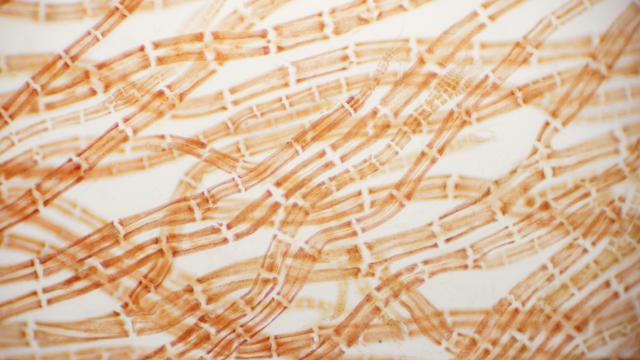The ancestor to pretty much all boning and photosynthesizing organisms might have been fossilized in Canadian rock. The only trouble is that scientists aren’t sure how old that fossil is.
Red algae, which looked really similar to Bangiomorpha (Image: Kelvinsong/Wikimedia Commons)
It’s hard to tell just how ancient any given fossil is, and accurate rankings of “oldest fossil” can be the subject of much controversy. Such is the case with an ancient alga, Bangiomorpha pubescens, which might be our great (great great great great…, etc.) grandparent — maybe.
A new analysis from Canadian scientists adds some new evidence that this strange creature is the oldest photosynthesising, sex-having organism.
“The fossil red alga Bangiomorpha pubescens is the only recognised crown-group eukaryote older than [~800 million years ago] and marks the earliest known expression of extant forms of multicellularity and eukaryotic photosynthesis,” the study authors write in a new paper published in Geology.
B. pubescens is a useful fossil for evolutionary origin stories, since it’s really old but evolved after whatever event caused photosynthesis, or using the Sun’s energy to produce food, to begin and after cells began having nuclei. It happens to look a whole lot like Bangia, a fresh water red alga that still exists today.
Original estimates pinned the B. pubescens fossil age to around 1.2 billion years old, but with a window of 500 million years uncertainty.
Now, researchers at McGill University have aged the rock around the B. pubescens fossil to 1.047 billion years, give or take 13 to 17 million. They used rhenium-osmium dating, a method of counting how much radioactive material has decayed over time in order to determine how old something is. This “cements the algae’s role” as the “most robust” date for constructing the early evolution of complex cells, the authors write.
Specifically, they’re referring to eukaryotes, the kinds of cells that envelope their genetic material inside of nuclei.
But solid answers aren’t that easy. “It is an extremely important fossil and has been quite controversial,” Andrew Roger at Dalhousie University told the CBC. He noted that he wasn’t sure it completely explained the origins of photosynthesis and eukaryotes — for example, there aren’t other recognisable eukaryotic fossils from earlier than 800 million years aside from B. pubescens.
Conversely, the paper mentions much older examples of fossils that might show eukaryotes, dating as far back as 1.8 billion years.
Life and its evolution on Earth continue to be mysterious. Regardless, it’s clear that we had to evolve from something in order to become what we are today — and that something did not look anything like us.
